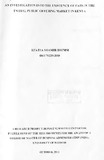| dc.description.abstract | The aim of the study was to test for the existence of fad explanation in the IPO market in Kenya. The study sought to examine the price behaviour of IPOs to test whether or not it was consistent with fad explanation. The research methodology was based on historical research design and relevant data was collected and evaluated of past IPOs. The data used in the study were offer prices, market prices and respective 20NSE indices which were historical and so secondary in nature and available at the NSE. The population included all companies that had been listed at the NSE since its inception in 1954 to ensure the selection of as large a sample. Judgment sampling was used where the sample had to conform to criteria and 25 IPOs were selected as the Sample. The data was analyzed by computing Price and Index Metrics to establish price behavior and determine market adjusted excess returns for both short and long term time. The study established that IPOs provided abnormal returns in the immediate aftermarket to investors who purchased at the initial offering. The mean rate of return earned over 1 day, 2 days, 20 days and 100 days respectively was 42.10 %, 41.71 %, 39.59 % and 23.87%. Under pricing of IPOs was observed with mean gain of 10.23% whereas median loss of-13.26 was consistent with fad behaviour and alternative explanations. Also there were no excess returns in the long run to investors who purchase the new issue in the aftermarket, supporting presence of fads and inefficient IPO market. Investors who purchased at the first aftermarket price underperformed the market index by mean of - 26.43% and median of - 27.72%. From the finding it can be concluded that fad explanations or mass psychology affected excess returns and exist in the IPO market. EMH was supported in the early aftermarket where full price adjustment occurred on the first day of trading. Recommendations for further research include the possibility to increase the sample size to cover all IPOs at the NSE since its inception and if possible, to examine cross sectional differences by issue size, offering price and underwriter class. | en_US |



